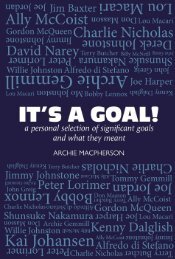Cool Scots by Greg Moodie sampler
What do Kenny Dalglish and Robert Louis Stevenson have in common? Or Annie Lennox and Mary Barbour? Or Joseph Knight and Sean Connery? They are but a few examples of the Scots that have shaped the cool nation we see today. In this whacky toon-fest of character sketches, Greg Moodie presents 42 key figures in Scotland’s rich and varied history. Spanning the living and the dead, the portraits range from potentially paranoid politicians and health-and-safety-loving Formula One drivers to Jacobite heroines and promiscuous poets. Basically, you get the best of the best. Accompanying each brief biography – peppered with quirky anecdotes, hilarious quips and mostly accurate facts – is a psychedelic portrait that blends past and present. Ever seen Muriel Spark sport a studded choker or James Clerk Maxwell boast two sleeves of tattoos? You will now. For once including those cool Scottish women so often ignored in history books, Moodie presents his collection ‘in an order deliberately designed to jolt your little minds out of their preconceived ideas of time’. You’ll leap between modern day musicians and 18th century science writers at the turn of each delightfully glossy page. Lavishly illustrated throughout, Moodie celebrates Scotland’s achievements, revels in its victories and occasionally blends fact and fiction.
What do Kenny Dalglish and Robert Louis Stevenson have in common? Or Annie Lennox and Mary Barbour? Or Joseph Knight and Sean Connery? They are but a few examples of the Scots that have shaped the cool nation we see today.
In this whacky toon-fest of character sketches, Greg Moodie presents 42 key figures in Scotland’s rich and varied history. Spanning the living and the dead, the portraits range from potentially paranoid politicians and health-and-safety-loving Formula One drivers to Jacobite heroines and promiscuous poets. Basically, you get the best of the best.
Accompanying each brief biography – peppered with quirky anecdotes, hilarious quips and mostly accurate facts – is a psychedelic portrait that blends past and present. Ever seen Muriel Spark sport a studded choker or James Clerk Maxwell boast two sleeves of tattoos? You will now.
For once including those cool Scottish women so often ignored in history books, Moodie presents his collection ‘in an order deliberately designed to jolt your little minds out of their preconceived ideas of time’. You’ll leap between modern day musicians and 18th century science writers at the turn of each delightfully glossy page.
Lavishly illustrated throughout, Moodie celebrates Scotland’s achievements, revels in its victories and occasionally blends fact and fiction.
Create successful ePaper yourself
Turn your PDF publications into a flip-book with our unique Google optimized e-Paper software.
ALEXANDER GRAHAM BELL<br />
(1847–1922)<br />
Scientist and inventor<br />
At first glance, it may seem odd that the person most closely associated<br />
with the invention of the telephone should have devoted the majority<br />
of his professional life to working with the deaf. But hey, that’s just the<br />
sort of complexity that makes <strong>Scots</strong> so cool. You’ll get used to this sort of thing<br />
as we go on.<br />
Born in Edinburgh plain Alexander Bell (‘Graham’ was an 11th birthday gift<br />
from his father after young Bell’s plea to have a middle name like his two siblings.<br />
Clearly the family had some social standing, as in those days only the wealthy<br />
could afford middle names), Bell’s father and grandfather were elocutionists, and<br />
both his mother and wife were deaf.<br />
At the age of 23, Bell emigrated to Canada, then to the USA, and developed<br />
a system called Visible Speech for teaching deaf children. He was fascinated<br />
<strong>by</strong> all aspects of speech and began conducting experiments into transmitting it,<br />
although being amongst Americans, it’s hard to see what kept him motivated.<br />
By 1875, Bell had developed a basic receiver that could turn electricity into<br />
sound and applied to have the device patented. Others had been conducting<br />
similar experiments at the time and there is considerable debate as to who<br />
correctly filled in the patent form first.<br />
Thus began Bell’s latter-day career as a court appearancee. It was an<br />
unfortunate situation given that the only thing worse than dealing with<br />
Americans is dealing with lawyers, and needless to say, dealing with American<br />
lawyers really is the pits.<br />
It’s telling that in later life Bell considered the telephone a nuisance and<br />
refused to have one in his study. But generations of teens would attest to the<br />
greatness of the invention, even if ironically their fascination with it might be<br />
contributing to the art of conversation’s decline.<br />
<strong>Cool</strong>ness rating: Too cool for America<br />
2


















